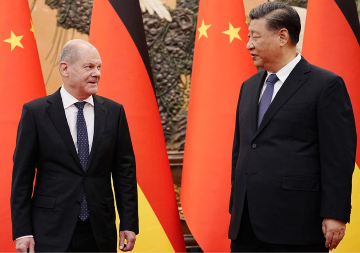ORF, in association with ETH, Zurich, organized a five-day workshop on 'Abundant Energy', conducted by experts from Switzerland who are trying to spread the message that shortages in global energy can be solved by generating energies from sources which are abundantly available.

Swiss energy experts, Prof. Ludger Hovestadt and Dr. Vera Bühlmann, firmly believe that energy shortage in the world could be overcome to a great extent by adopting a fresh, rational approach where governments lay greater emphasis on generating energies from those sources which are available in abundance, rather than relying only on those that are finite in nature.
Prof. Ludger Hovestadt and Dr. Vera Bühlmann of the Swiss Federal Institute of Technology (ETH), Zurich, explained their ideas to a group of selected students who participated in the five-day specially designed workshop on ’Abundant Energy’ organized by Observer Research Foundation from 8 to 13 December 2010.
The ’abundant energy’ theme was selected by Prof. Hovestadt and Dr. Bühlmann in view of the growing world-wide concerns on energy scarcity. During the workshop, numerous thoughts and ideas on the abundant energy concept were discussed, such as (a) living in a world of abundant potentials, (b) technological details, (c) cultural implications, (d) creating new values, and (e) future cities; and students were engaged in energy discussions. On each day, presentations were delivered by Prof. Hovestadt and Dr. Bühlmann, and there was a constant interaction with the students to understand how much they have learnt. The effort was to discuss a provocative hypothesis and share a principal idea in order to generate interest among students.
The main objective of conducting the workshop was to stimulate students, and to lay the foundation for discovery of new concepts. The topic is also being extensively researched by the ETH faculty in order to refine the concept by way of holding workshops, and interactions with students, policy makers, lecturers, opinion leaders, artists, politicians, and scientists.
Prof. Hovestadt argued that generally a mechanical approach is adopted by the stakeholders in developing the environment which is quite often based on false statistics, and so, there is a need to look at the current global environmental crisis from a different perspective. According to him, the problem with statistics is the outcome of thinking and scientific developments that took place during the nineteenth century, wherein different elements are generalised and treated in almost the same way. He said it has nothing to do with the abstraction that one is looking for. Such generalisations do not offer sufficient solutions because the differences of various elements are ignored. For example, if two different types of fluids are mixed, their individual qualities vanish. He suggested that it was important to focus on the differences, and maintain a clear balance of differences and qualities.
Prof. Hovestadt said that today’s political leaders are focusing on entropic processes which are produced by using statistics in a certain way, and that such catastrophic behavior (or a short term solution) is part of their aggression and not of our environment.
Dr. Bühlmann said that it is not really a crisis of energy but of the rational. She said like in the case with computers and other automation machines, there is a tendency towards being very predictable. Actually, what is needed is to re-define our world of capacities of reasoning, she clarified. Giving the example of the Sun, it was pointed out that it not only illuminates the earth, it is also an important source of energy. The radiation can be converted into electricity. The solar stream is stored in the winds, tides, water, plants, grass, flowers, forest and the whole natural environment. Thus, the planet offers enormous opportunities for tapping energy.
Dr. Bühlmann was also critical of the present day discourse used to address the environmental crisis, which she says is driven by sophisticated technology. She said this was very much like an imperialistic approach which would ultimately result in harming nature; and that mankind is exploring, exploiting and enjoying the potential which exists in current times. She shared a conversation that took place with members of the Clinton Foundation about the emergence of a solar society in about 40 years time; and the immediate need to find ways to implement certain regulations, organize the political systems, etc.
Prof. Hovestadt emphasized that energy should be orchestrated in a rational way. What is happening today is that energy is being looked at as something which is scarce, and there is a constant fear of running out of resources. He pointed out that there is plenty of energy around and it is actually a crisis of intuition. What is needed is to look at the entire problem from a different perspective.
In terms of meeting the energy needs, Prof. Hovestadt said that mankind should emancipate itself from being more abstract and find innovative ways without disturbing the environment. In this respect, he discussed the possibility of using photovoltaic cells1 for making cheap energy, as against the current thrust of governments on the establishment of nuclear plants for which billions of dollars are allocated, and that such measures are being seen as a new way of organizing in the living environment. He said sufficient energy can be generated in this manner, and nothing is burnt or destroyed.
Numerous examples were given by Prof. Hovestadt to explain the concept of abundance. For instance, the network established for the flow of information and voice (such as the internet and the mobile phones) caters to the needs of unlimited number of users, anywhere on the planet. In his perception, this is abundance, and similar principles can be applied for generating energy, such as by using solar technology. It was also mentioned that mechanical systems (such as a wind mill) are much more complicated and require a lot of resources and engineering. Furthermore, it was stressed that one could see the same problem from two sides, and accordingly prepare two business models based on two technical solutions. Then it should be left to the market forces to decide - what is cheaper, what is more flexible, and so on.
It was pointed out that more than 40 per cent of the energy (based on gas, fossil resources, wood, coal, oil, etc.) is used in houses/buildings, which is more than double the amount of energy used in traffic worldwide. In this respect, he spoke about transporting energy based mainly on electricity and that energy requirements of buildings could be easily met by electricity, which would also address the problem of global warming resulting from rising carbon dioxide levels. According to him, this could be done in a short period of time by laying down the cables, orchestrating all the electronic devices plugged in, and such arrangements would be quite economical. In this approach, the investment per electrical device would be only on a piece of silicon chip (to be fitted in any power plug/device) costing about one USD, and this could be a substitution to the large mechanical infrastructure (such as a transformer) currently in use. Besides, this would be a very clean and convenient way of meeting the high level of energy required for heating, cooking, and all other purposes. In his perception, electrical current means that energy is simply available.
The technical problem faced today is the existence of a highly volatile pattern, in terms of energy consumption by different users, which is difficult to control, and that people are using energy as they want. Giving the example of an institute in Logan, students were told that sensors are being used to predict user behavior, based on which consumption is minimized/controlled. Similarly, in the case of housing, if one is able to predict the energy consumption pattern, the climatic profile could be adjusted to people’s need.
For controlling temperatures inside houses, it was mentioned that houses can be easily heated by using solar cells, while cooling needs no energy since this can be done by using the right foils. It is very important that the solar cell radiation is at an angle of 90 degrees to solar cells, and if it is a little less, then efficiency is extremely low, and the whole solar quantum effect does not work especially when it gets cloudy. He pointed out that new types of solar cells, which have more friendly curves of efficiency, are being developed.
Prof. Hovestadt said that energy has different levels which could be transferred from one level to another. Thus, for meeting the energy needs of buildings, three principal sources of energy could be used - ground, house and the radiation and air outside. What is important is to transfer in the right way the flow of energy by developing appropriate technology - from the air to the house and vice-a-versa; and from the house to the ground and vice-a-versa.
Fifteen students, who took part in the workshop, were from varying background - studying english, history, economics, political science, petroleum and energy management, international relations, and business administration in different educational institutions situated in Delhi, Uttar Pradesh and Uttarakhand, such as Rajiv Gandhi Institute of Petroleum Technology at Rae Bareli (Uttar Pradesh), University of Petroleum and Energy Studies at Dehradun (Uttarakhand), Jawaharlal Nehru University (New Delhi), University of Delhi, and National Museum Institute (New Delhi).
The students were divided into five groups and each group was guided in the preparation of a business plan model for generating energy based on abundance principles, which was later followed by group presentations. The presentation titles were ’Use of piezo crystals for energy generation’, ’Tapping the untapped’, ’Electro-villa’, ’Monopolization of rare earth minerals’, and ’Captive use of solar energy’. All the students were given a certificate of participation by Prof. Hovestadt and Dr. Bühlmann.
(Dr. Rumi Aijaz is a Fellow at ORF and Mr. Manish Vaid is a Research Assistant).
Names of students/participants
Endnotes
1 Photovoltaics (PV) is a method of generating electrical power by converting solar radiation into direct current electricity using semiconductors that exhibit the photovoltaic effect (Wikipedia, 2010).
The views expressed above belong to the author(s). ORF research and analyses now available on Telegram! Click here to access our curated content — blogs, longforms and interviews.




 PREV
PREV

